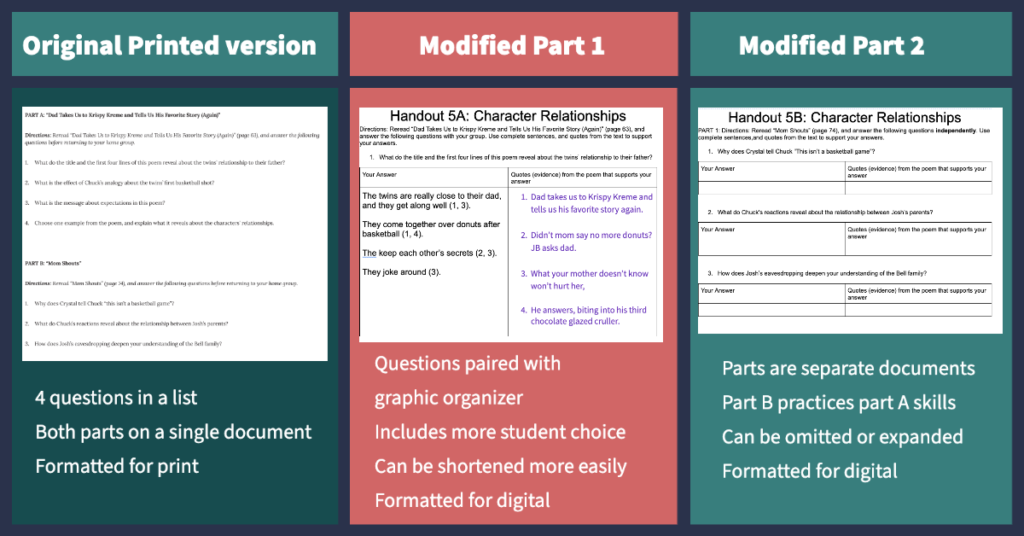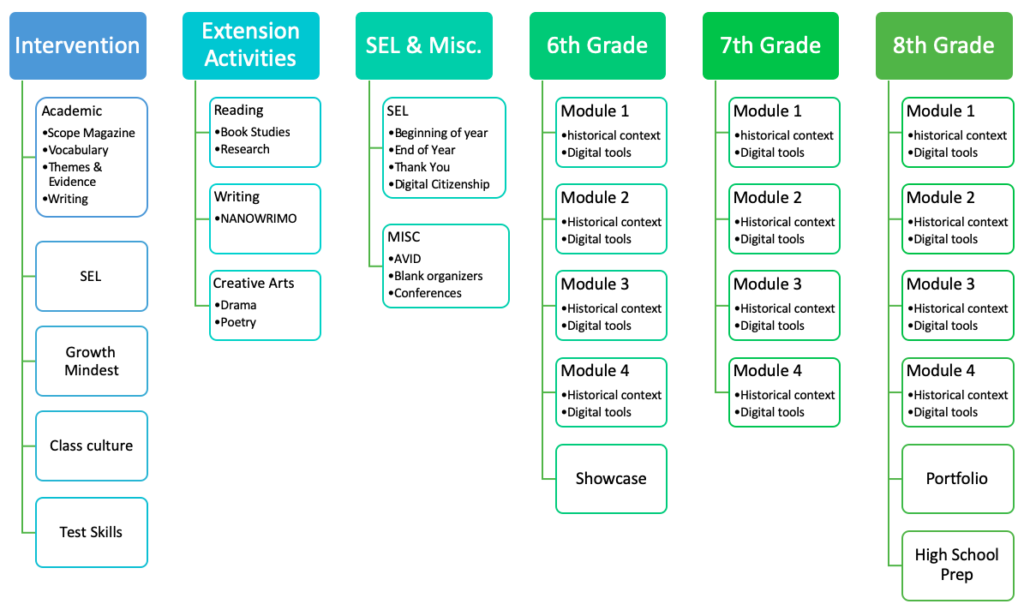Building Materials
Our district uses a rigorous standardized curriculum for English classes from kindergarten through eighth grade. This allows lessons to build consistently from when students first learn to read and write through the academic writing required for high school. Additionally, we are an AVID school, so students use specific structures to take notes and organize their thinking. As a result of these two elements, many of the graphic organizers can be used at multiple grade levels. Digitizing the graphic organizers and making them accessible for teachers allow students who are unable to attend school in person to use these tools and practice essential skills alongside their peers who are in person.
The rigor of our district curriculum helps students gain essential skills for high school, but it also means that teachers have to build out scaffolded materials and adapted versions of the assignments for students for whom English is their second language or students with learning differences that make the standardized assignments inaccessible. The two aspects of the standardized curriculum that make it particularly difficult for these groups are the wording used for writing prompts and the published digital versions that are not compatible with our learning management system.
Digitizing print handouts and differentiating them is an important element of my teaching. I wrote about differentiating materials when time is limited in a post in August 2021. Differentiation begins with digitizing student handouts that are formatted for print requires organizing the materials differently in ways that take advantage of digital tools. For example: splitting a two part document so that it is easier to see on a screen and so that students who have an accommodation for shortened or chunked assignments can better access the materials. Use of graphic organizers in digital assignments makes them easier to read on a screen.
The example below shows how a functional, rigorous print assignment can be made into an equally rigorous digital assignment that meets the specific needs of our students.

Digital tools beyond google docs increase the versatility of the print assignments. For example, printed quizzes can be moved to a google form and made into a self-grading quiz, brainstorming can be conducted on Jamboard, and embedded links can allow students to expand their understanding.
Not all tools need to be digitized for modification. Sometimes, moving from a digital medium to a hand-written one also supports differentiation. For example, the standardized district curriculum includes videos teaching students vocabulary they write in their journals. Other lessons include varied methods of learning vocabulary (Frayer models, for example), and differentiation allows educators to incorporate those methods into the vocabulary video lessons. For example, adding an art or doodling component to the vocabulary lesson allows students to build their understanding of a word meaning in a visual way. This project is a way to gather all of these differentiation and student-choice methods into an organized place accessible to others in the department.
Organizing Materials
For this project, I built a centralized folder where teachers could access the differentiated materials that we’d built. By centralizing the folder, it meant that access to the materials would not be limited by how well each individual teacher knew the other teachers and access to their materials. But, centralizing the resources brought up challenges that are characteristic of any program that includes a diverse population of users whose experience, methodology and technical expertise varied widely. Our department used shared resource drives in the past that had grown organically over the decades, and without a standard organizational format they became chaotic and difficult to navigate.
To prevent this, I needed to set up an organizational system that was robust enough to include the varied resources needed to teach middle school humanities and simple enough to be navigated by varied users. Most humanities teachers also taught a reading intervention class, so I began with that, and then divided the folders into grade level and extension activities that could be used for any grade or for classroom culture. These folders were:
- Intervention
- Extension Activities
- SEL & Misc.
- 6th Grade
- 7th Grade
- 8th Grade
Each folder is divided into additional folders that include the materials needed. The organization is shown in the flow charts below.

The intention of separating three of the general topics from the grade-specific topics was to allow teachers to access the greatest number of support and extension activities as possible in a single space. It also encourages cross grade-level collaboration because three of the folders are meant to be accessed by teachers of all grade levels.